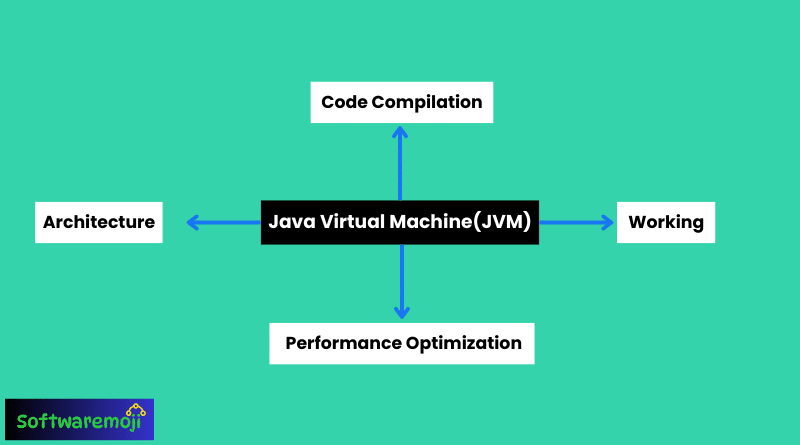
- The Java Virtual Machine (JVM) ensures platform independence by enabling Java programs to run seamlessly on any operating system.
- JVM offers automatic memory management through garbage collection, reducing the risk of memory leaks.
- With Just-In-Time (JIT) compilation, JVM optimizes code execution for high performance in real-time applications.
- JVM supports multiple languages like Kotlin, Scala, and Groovy, making it a versatile choice for modern development.
- Built-in security features in the JVM sandbox model protect applications from unauthorized access and execution.
👉What is JVM (Java Virtual Machine)?
Java Virtual Machine (JVM) is a crucial component of Java’s platform independence. It is a runtime engine that converts Java bytecode into machine-specific code, enabling Java applications to run on different operating systems without modification. Unlike other programming languages, where the compiler directly produces machine code, Java compiles its code into an intermediate bytecode, which is then executed by the JVM.
👉How Does JVM Work?
- Compilation to Bytecode – Java source code (.java files) is compiled into bytecode (.class files) by the Java Compiler (javac).
- Class Loading – The ClassLoader loads the compiled bytecode into memory for execution.
- Bytecode Verification – The JVM verifies bytecode to ensure security and correctness before execution.
- Execution by JVM – The Execution Engine converts bytecode into native machine code using the Just-In-Time (JIT) compiler.
- Memory Management – JVM manages memory dynamically through automatic Garbage Collection.
👉JVM Architecture:-
JVM consists of several components that work together to ensure efficient execution of Java programs:
1. ClassLoader:-
- Loads Java class files dynamically when required.
- Performs Loading, Linking, and Initialization.
2. Runtime Memory Areas:-
- Method Area – Stores metadata, runtime constant pool, and method bytecode.
- Heap – Stores objects and instance variables, shared among threads.
- JVM Stacks – Stores method-specific data such as local variables and intermediate results.
- PC Register – Keeps track of the next instruction to execute for each thread.
- Native Method Stack – Holds data for native methods written in languages like C or C++.
3. Execution Engine:-
- Interpreter – Translates bytecode to machine code, but is slower.
- JIT (Just-in-Time Compiler) – Converts frequently used bytecode into native code for faster execution.
- Garbage Collector (GC) – Manages automatic memory allocation and deallocation.
4. Native Method Interface (JNI) & Native Libraries:-
- Allows Java to interact with native libraries for better performance.
👉Java Code Compilation & Execution Process:-
Java vs. C Compilation:
| Feature | Java | C |
| Compilation | Produces bytecode (.class) | Produces machine code (.exe) |
| Linking | Dynamic at runtime | Static linking |
| Execution | Uses JVM | Uses OS & CPU directly |
Why is Java Both Compiled and Interpreted?
- Compilation: Java source code is compiled into bytecode.
- Interpretation: JVM interprets the bytecode at runtime.
- JIT Compilation: Optimizes execution by translating frequently used bytecode into native code.
👉Java Virtual Machine (JVM) Performance Optimization in JVM:-
1. Just-In-Time (JIT) Compilation–
- Converts bytecode to native machine code at runtime.
- Reduces interpretation overhead and speeds up execution.
2. Garbage Collection (GC) Optimization–
- JVM automatically manages memory using various GC algorithms like G1, CMS, and Parallel GC.
- Efficient GC tuning enhances performance.
3. Adaptive Optimization–
- JVM optimizes execution based on real-time profiling.
- Methods frequently executed are compiled into native code dynamically.
4. Thread Management–
- JVM efficiently handles multi-threading using Java’s concurrency features.
👉Optimization for Java and JVM:-
To rank better for Java-related searches, consider these strategies:
- Use Long-Tail Keywords:
- “How does JVM work?”
- “JVM architecture explained”
- “Java performance optimization techniques”
- Optimize for Featured Snippets:
- Structure content with bullet points and concise explanations.
- Include Internal Links:
- Link to related Java topics like “Java Memory Management” and “JIT Compilation”.
- Add Engaging Multimedia:
- Include images, infographics, and code snippets to enhance user engagement.
- Write for Readability:
- Use short paragraphs, subheadings, and simple explanations.
👉Java Virtual Machine (JVM) Conclusion:-
Java Virtual Machine (JVM) is the backbone of Java’s cross-platform compatibility. By understanding its architecture, execution process, and optimization techniques, developers can enhance application performance. Implementing best practices ensures that Java-related content ranks well in search engines, making it more accessible to developers worldwide.
